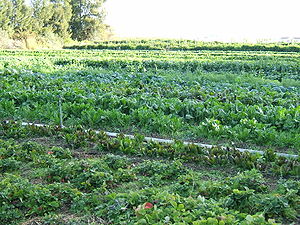GREEN FIELDS
Elpidio V. Peria
18 June 2010
The Philippine Organic Agriculture Act, a Measure for Environmental Protection, by
Indirection ?
Just today, a long-time environmental activist-friend sent me a text message that Republic Act 10068 or the Organic Agriculture Act of 2010, as it is otherwise called, has just been published, in the national daily
Philippine Star, in its page B-11.
Counting fifteen days from today, or on
3 July 2010, this law shall have taken effect all over the country. Along with other bills passed into law by the recently-adjourned 14th Congress, this is one of the most awaited measure by most
advocacy groups, especially those espousing
organic agriculture, farmers' groups pushing for the upliftment of the livelihood of farmers, consumers' groups who have just been recently awakened to the benefits of eating pesticide-free farm produce, including those that are not contaminated by genetically-modified organisms, and perhaps even
environmental activists who consider themselves protectors of the environment, or of clean air, clean water and a healthy functioning ecosystem.
Wait a minute, you would say, why would the latter group be excited in this kind of legislation when this measure is supposed to promote, what can be considered a booming part of the agriculture sector whose rate of growth is much faster now, compared to conventional agriculture ? As naysayers would say : what is this law doing masquerading as an environmental protection measure, it cannot be many things all at once to so many people, and to environment, and to agriculture and to the economy, in general.
But it seems the new law has managed to do just that.
The Declaration of Policy in Sec. 2 of the Act makes it explicit that : “It is hereby declared the policy of the State to promote, propagate, develop further and implement the practice of organic agriculture in the
Philippines that will cumulatively condition and enrich the fertility of the soil, increase farm productivity, reduce pollution and
destruction of the environment, prevent the
depletion of natural resources, further protect the health of farmers, consumers and the general public, and save on imported farm inputs.”
Contrary to what the title of this column indicates, this law is an outright or direct environmental protection measure, not only as indicated by the underlined phrases from the law's Declaration of Policy but also from sec. 13 of the law itself, which reads :
Sec. 13- Organic Agriculture and the
Protection of the Environment – The National Organic Agriculture Board (NOAB) shall constantly devise and implement ways and means not only of producing
organic fertilizers and other farm inputs and needs on and off the farm but also of helping to alleviate the problems of industrial waste and community
garbage disposal through appropriate methods of sorting, collecting and composting. The BAFPS ( or the Bureau of Agriculture, Food and Product Standards) shall conduct continuing studies , xxx to advise local governments, from the barangay to the provincial level, on the collection and disposal of garbage and waste in such a way as to provide raw materials for the production of
organic fertilizer and other farm inputs.
While this provision can be interpreted to mean that the first law passed by GMA in her then heady days in 001 as a newly-installed President via People Power II, the
Solid Waste Management Act, or
Republic Act 9003, has largely failed, (for, if the law had only succeeded, this provision would be unnecessary) then it is time for another approach to solving this seemingly intractable problem of solid waste, and presto, here it is now - organic agriculture - a savior for our collective sins on our modern tendency to dispose mindlessly what we use day in or day out. .
But, how then can this law be applied, to, for example, mining, which is out and out destructive as an environment-friendly activity notwithstanding the claim of MGB officials about responsible mining, and which, has blanketed almost all environmentally-rich areas of the Philippines ?
Or how about aerial spraying, which has spread specks of harmful chemical all over where there are plantations, of mainly, banana, for now, but inadvertently affecting the people living nearby in these
plantation sites?
Or how about genetically-modified organisms, of which the National Committee on Biosafety of the Philippines, under the DOST is currently undergoing multi-location trials of
genetically-engineered eggplant
(Remember this plant in Tito Vic and Joey's ditty/spoof of the Beatles'
The Long and Winding Road : “Talong at bagoong, ang ulam namin ngayon, talong at bagoong, ulam buong taon!”) in order to, for the first time, feed it to us, directly? This law however subscribes to International Federation of Organic Agriculture Movement (IFOAM) standards of organic agriculture, thus it even explicitly states that
GMOs are not contemplated by the law when it talks about biotechnology, which is one of its approaches to achieve its aims.
The implementor of the law, the BAFPS (Bureau of Agriculture and Fisheries Product Standards) of the
Department of Agriculture (DA), is in a quandary on this issue, that is why, the DA should not be promoting and regulating biotechnology, all at the same time as it is in obvious conflict of interest, but that's another story for another write-up.
It must be noted that this Act has been passed, almost in parallel with similar local issuances, like the one in Davao City and just very recently, in Negros Oriental Province.
What, then, can environmental advocates do, to strengthen the law'spotential as an environmental protection measure?
The law provides the answer in its sec. 26 (a), which penalizes any person who willfully and deliberately obstructs the development or propagation of organic agriculture, or the manufacture, production, sale or use of organic agriculture inputs.
The potential of the law as an environmental measure lies in the ability of advocates not only in LGUs where there are Organic Agriculture ordinances but in all areas of the Philippines, to stop any environmentally-harmful activity, such as the ones mentioned above, by invoking said sec. 26 (a). Of course, if one has not engaged in organic agriculture yet, or is just planning to, that can be another question that will be known later if someone litigates on precisely this issue, or perhaps the drafting of the IRR of the law can clarify that.
Of course, organic agriculture advocates would insist, and this goes without saying, the basic allure of organic agriculture is its being kind to the environment, and recent studies bear this out. Recently, the
Third World Network Information Service on
Sustainable Agriculture, reported studies by two organic
agriculture research institutions – the
Rodale Institute in the US and the FiBL, or Research Institute of Organic Agriculture in Switzerland - which found that organic agriculture is well placed to mitigate as well as help farmers adapt to
climate change.
These research institutions said that the mitigation potential, or ability to reduce over-all
greenhouse gas emissions, amount to about 9–13 percent of the global total. This is due to its significant capacity to sequester or capture carbon in soils. Organic agriculture also reduces emissions as it emits less nitrous oxide (due to lower nitrogen input), less nitrous oxide and methane from biomass waste burning (as burning is avoided), and requires less energy, mainly due to zero
chemical fertilizer use. At the same time that this is happening, organic agriculture increases soil organic matter, and improves
soil quality thereby reducing vulnerability of farm areas to extreme weather events. Furthermore, the high diversity of crops and farming activities in organic agriculture, together with its lower input costs, reduce economic risks for farmers.
Indeed, this law has potential, and it is high time that not only organic agriculture advocates know that.
oOo
 Convention on Biological Diversity's Cartagena ProtocolImage by _ Krystian PHOTOSynthesis (wild-thriving) _ via Flickr
Convention on Biological Diversity's Cartagena ProtocolImage by _ Krystian PHOTOSynthesis (wild-thriving) _ via Flickr







